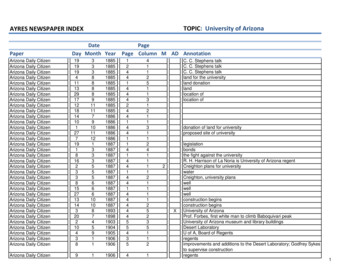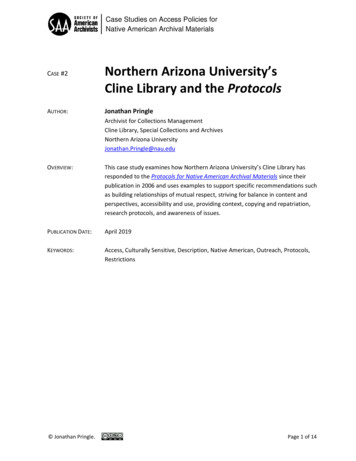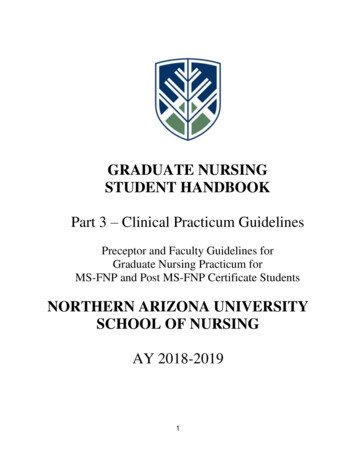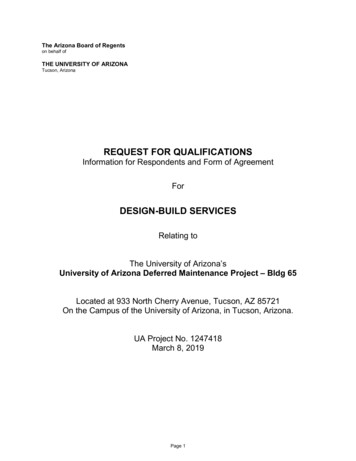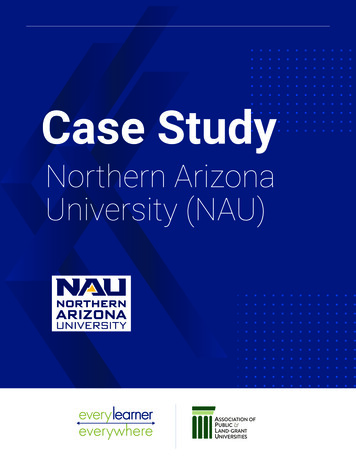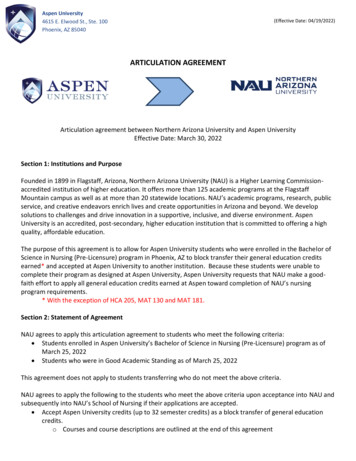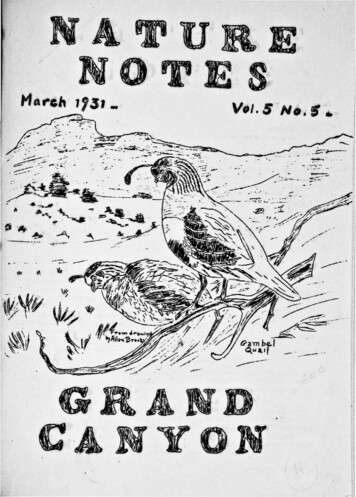
Transcription
NATURENOTESv.1. 5"', .GRANDCA.NYONNo. S .
UNITED STATJi:SDEPARTMENT OF TFE INTPRIO NATIONAL PARK SERVICEGRAND CANYON NATIONAL PARKVol. 5Grand Canyon Nature NotesNo.5.Karch. 1931- - - - - - .- - - - - - --. This Bull tin is iss ed monthly for the purpose of giving informatlon to those lnterested ln the natural history and scientific featuresof the Grand Canyon National Park. Additional copies of these bulletinsmay be obtained free of charge by those who can make use of them, by addressing the Superintendent, Grand Canyon National park Grand Canyon, .'- -- -- - - - - - - - - - - - - -- - -K. R. Tillotson, Superintendent -- Clyde C. Searl, Acting Park NaturalistPauline Mead, Ro.nger Naturalist.Table of ContentsEdwin D. McKeeFossil Footprints of the CoconinoClyde C. Searl, Acting Park NaturalistSedimentary RocksRanger-naturalist Pauline MeadThe Rock Loving Alum RootOfficial Report on Stocking CanyonChief Ranger J. P. Brooksstreams wi th FishRangerChester R. MarkleyThe Raccoon of HavasupaiFourth Report on ·the Germination ofRanger-naturalist Pauline MeadNative WPd Flower Seeds------ - - - - - - - - - - - - - - - Yr. Edwin D. McKee, who resigned as Park Naturalist on November30, 1930, in order that during the winter months he could continuehis university studies leading to a doctorate, will be reinstated andresume his duties about April 1, 1931.During his absence Mr. McKee prepared and published an illustrated ham book entitled "Ancient L9.ndscapes of the Grand CanyonRegion".The book comprehensively, yet in simple . language, outlinesthe geologic story of the Zion, Bryce, Petrified Forest, Pain edDesert and Grand Canyon formations, and will be found of conslderab1einterest and value by the visitor to these regions.P. P. patraw -
FOSSIL FOOTDRI NTS'OF THE COCONINOBv Edwin D. McKee.Recently while reviewing literature in connection With the preparation of a pa er on ti1.e Coconino fomation (not vet published), the writerwas greatly mpressed wi. th the ?'ealth of interesting lTJW.terial accumulatedby Dr. C. W. Gilmor? in his three blJJetins on the fossil footprints ofthat fonnation.S nce these public'ltions are alreadY out of print andare probably unknown to many of those interested in the wonders of GrandCanyon, a brief review of thel r cont ent s tog.e ther with a few per sonal observations are here pre sented.The tracks of the Coconino sandstone were first brought to scientific attention in 191 5 when Prof. Charle s Schuchert of yale Uni Tersityde a small collecti6n along the Hermit Trail. A study of these and thedesert ption of several of them was undertaken by Prof. Lull. In 1924 an extensive study of the Coconino footprints by Dr. C. W. Gilmore of the U. S.National Museum was made possible through the intere st of Dr. John C .Merriamand was continued for several years. The results of this splendid work were' published in the Smithsonian Miscellaneous Puglications 2832, 2917, 2956.All of the Coconino foot prin ts are Qonsidered to be those of quadrupedal animals though they vary extremely in size and character. Some appearto mve been made of animals not larger than small lizards; oti1.er s apparentlywere formed by oreatures having large feet and strides nearly a yard inlength. Some indicate short-limbed, heavy, widebodied animals, while othertracks suggest animals having long slender limbs and narrow bodies.Dr. Gilmore states that the tracks of the backboned animals in theCoconino sandstone suggest a correlation with the rocks of Permian age inTexas where occur skeletons of many kin ds of extinct creatures some of whichhad the right proporti on of foot, limb and body to have made imori nts similar to those found at Grand Canyon. It see"lS fair to assume that such animals formerly also inhabited the Arizona region. If the se deducti ons arecorrect, then the tracks repre sent pri miti ve crawling reptiles and B.'llphibiansall of which were unlike any creatur es living todaY. Trllils made bv invertebrates, and burrows probably formed bv woms lso occur in the Coconino.In summing up the faun of ti1.e Coconino s dstone, Dr. Gilmore st testhc-t it is, "Co.rboniferous (o.ge) in aspect :l S shown bv the relc.tiv?lV smo.llsize of the o.nimnls 0.11 of which o.re quadrupedal, o.s contr.l.sted Wl. th theconsiderable number' of very 13rge fonns nd m ny three-toed bipedo.l o.ni lsof the Triassic (period). Taken as whole, this fauna which now co siS S of15 genera and 22 species seems to have closer relationships to the chn tefauna from the Middle C. l Measures of Kansas described by Ma sh than to themore extensive fauna fran the Coal Measures of Nova Scotia made own by.Dawson and Matthew. The predom.ino.tiDg species is Laoporus noble YdUchnppnrently is present wherever coconino tracks are founi."43
The footprints occur preserved ,on the upper surfaces of inclinedbedding planes.Many of thom arc be a,Utifully distinct r.nd the courses ofanimals c a n often be tr;:. ced for consid"brab le di str.nces.Rega rding thc .lack of organic remo.ins, Prof. Schuchart consid e rs that t!' i;; is "prolx:.blydue to the originally loose and repeatedly reworked sands, a most unfavorable habitat for animals".A peculiar feature of the occurrence of the Coconino trncks is8Ul11!1ted up by Gilmore in the following st At -m"'nt, "Th(' trend of Of"lrly allof the tr :;.cks .nd trr.ils w-, 5 ' in one diroction, th" t is, up the slope ofthe crossbedded s ndstones -- ' nd thc- ey min tior. of m nv ad itional chundred square feet of tr'lck-covered surf'\ce verifies this original obser- .v:ltion.In t,ll of the hundreds of tr'",ils seen, only three exceptions werefound "At ', mother pl"ce Dr. Gilmor':. r c fc.rs to this fe1 t urc ', s suggestiveof " :J.n old tr' il )e",d:ing to the w),ter, or possibl" -- , great migration of::.nimal life such :. s is occ.l.sion 'l.lJ " known to t .ke phce ilmong tre aniJ!1(.lsof the prescnt time."The gcogr phic l r, ge of the footprints of the Coconino s dstoneis esscnti-llly the s.:.me i:. S th:. .t of the formJ.tion itself.In the GrandCanyon region, the vrriter s personally found Coconino tr cks ne r Seligman and Flagstaff, and along the Tanner, Hance, Grand View, Yuki, Kaibub,Bright Angel, Hermit and Bass tra ils, and ho has seen specimens from nearPine, in the University of Arizona collections, thus showing a very widespread and genera l occurrence.Tho vertical range of footprints in the Coconino is described byGilmore as, "eonfined to the bas:'.l 150 f"eet of the fOrnI:.tion of which thelowermost 20 arc b a rren", and again, "so f .r as knovm, (tra cks) arc foundonly in the lowor half".The only exception to this thnt has come tothe writer's attention i's on the Yaki Tj'a il where tracks occur in placesat least 'midway in tho upper half.Foot prints aopeJ.r to be most abundantabout the l50-foot level, but apnnrontly occur at almost every level from.t re down.The only definite corrE,latio n of the Coconino trn cks suggestedbv Dr. Gilmore is the followi.ng:"Recogni tion h'1.s been me.de of genericnlly-like if not spccificall" simihr tr 't)\cs found in the Coconino s".ndstone of Gr "md C'lOYon "nel ti t' Lvons s ",ndstone of Color'- do",It '\150 seBIlISworthy to noto th , t Dr. Gilmore found none of the geners of the Coconinorepresented in the t1'IO und 1ving. tr' ek-be lring fo 1""1 .ti ons of Gr·.m C:lllvon.n 'lIIIely the Hermit !\Ild Supd.er
\\SEDIMENTARY ROCKSBy Clyde C. Searl. Acting Park Naturalist.A common question brought up by conversations and lectures at theYavapai observation station concerns the difference between various typesof rock.As the lecturer explains that the rock which forms the wallsof the inner gorge · are igneous, and that the dolored ' rocks which appearabove the inner gorge and extend to the top, are' chiefly organic and sedimentary, it is not often clear to the listener just what the differenoesare between the types of rock.The term "igneous" ; does not accurately describe . the . rocks of theinner gorge.Literll-lly; the word means "fiery" and has long been in useto inolude all rocks which have actually Qeen melted within the earth, orWMch have be n thrown out on the surface by volcanos.In sbort, igneousrocks owe their origin to some of the effects of the internal heat of theearth far beneath the surface.'0In the Februarv issue of Nature Not s, an article dealt almos entirely with t formation of organic rocks.On Iv a few brief statementsdescribing that type of rock wi n be given here.Since leil.ves branohesand stems of .plants, and the 's hel1s or otJ-er remains of animals, are scattered sb abundantI V through ordina rv dirt: -.nd s!'.nd, it is ellSV to understand thAt some times the'! mav occur i!1. such quantitv ,,-s :·to form greatdeposits of emselves.V'e m!w teMl.the'II org .nic rocks, or organic!1llyderived rocks; bec. . use · they owe th eir Cl"igin to the accumulation of who.t areculled cirgo.n\c rem ,ins, the' rem:1.ins of phnts '. TId ', nim" Is.0Sedimf;lnt.:.rv rocks, the t -'pe with which this ::.rticle will de;1l, arejust s interesting s are the org nic .rocks with their countless numberof animal skeletons, but it must be ·. ldmitted th c,t the intere.st of thesediment" ry rock is oincrea sed bV the presence of many org.mic remains.Such is the ca se in 'the sedimenta ry r cks ' .01' the wulls 01'0 Gro.nd Canyon.Briefly, sedimentary rocks :].re mc,de up, :.:s the nc.me implies, of gr;1vel,sund and mud.How these mo.teri a ls have been g::-thered together r.nd hardened into solid stone is question the. t . bathe rs ma. ny pea pIe who nre getting their first lesson or t ste of geology e.t the Yav apa.i Station.Itis eaSily exp.laine d bV the things th:'ot can be pointed out directly to theinterested party.It is easily demonst .ted thnt the Colorado Riv6r at. the pointbelow Yuv:lpni is (" very muddy stream a nd by reference to . the d tn of theUnited Stoltes Gl;!ologic:lI Survey g:;thered'bv .da ily re:tdings .t o.ken nt thevnrious gnuging stations along ·the river; tho.t the sedime t transportedbv the r1 ver reaches enormous quo.nti ties.Then bv the (nd 01'0 ph?to.grnphs Oond of models on displ"1V in the exhibi. t rooms of the bUl.ldl.ng upof the river's del t o. at -the ' Gulf of Cn.lifornio., it become s easy bv theeXQJnple to mr, ke (cleo.r how mcmv of the l :wers of rock in the Wlllls of'Grand Cnnyon wl/re built up in "- ges pr,st,045
It is true tha t 0. large quantity of t he riul teri al po.ssi throughGrand Canyon will become deposited " long the vn v, but so long '\s 0. currentof W!lter is moving swiftly,' it keeps the g ravel, sand, and mud from settli to the bottom.A very r o.pid current will co.rry olong not only gr o.veland sond and mud, but even much l a rger bodies of rock. A stream does nothave w increa se its veloci t y miny times to en:lble it to carry huge boulders by rolling them ove r nnd ove r. .s the current's spe e d decreo. ses thehe uvy rocks will ce o.se to ro 11; gr o.vels wi 11 5 ink to the bottom . s sedi ment;next the sand will settle, and the mud, being light er, will be c:lrried muchfarther until it, too, will settle to the bottom. Assuming that the crustal movement of the e o.rth, which is go ing on in numerous l o. ces tod y,should cnuse 0.' slow dropping of the surfo.ce of the e a rth a t the mouth ofn river, it co.n reo.dily be see n toot 1hick lo.yers of mud wi 11 graduolly bebuilt thioker. In time the pressure , with the ' c. lways ccanpo.nying heato.nd the nnturo.l cementing qua lities in the mud, will turn it inw stone.Such WIlS the story in the GrD.1rl Ca ny on. At time s the re gion was -,t he mouthof the river, and the crusta l movement of the earth re suI ted in 0. gro.dualsinking, until greo.t lo.yers many hundreds of fee t thick came into existence.If one stands on tne suspension bridge which spans the river at apoint visible from Yavo.pni, it will be notice d t h.'1.t branches of treesj logs,and occasionally the body of acme o.pimo.l are carried by in the streo.m,These dead animnls and the other debris are carried fo.r down the streamand buried in the mud. And if om goa s to th e' delta region of the ri '(er,trc.cks of nnimo.ls C'1.n be seen on tre wet bo.nks, or on th e be:J.ch exposed atlow tide. Some of the impressicns wi 1) h .rden before other silt is placedon top, nnd in this wnv the imprints wiD be se;-.led unti 1 brought to lightngo.in by the forces of erosion or the interest of mo.n. Then coming bo.ckup too trail from the bridge, the qU l rries where fossil ferns lie superimposed one ,:.bove the other, ::.nd the foo tprints ' of animals exposed by theblo. sting of the trc.ils, t ':.ke on u. dee. per. . me o.ning.During a wo.rm spell the first pu rt of tho month of March, twoliznris of the genus uta were seen da ily disporting themselves on the 'W:l.lkof ynvnpni Observation Station.Both wore very young lizards und it ishighly possible thnt experience had not yet taught them tre.t it wns indiscrete to oome out until Wllrm wecthcr WllS surolywith us. Tho presentcold spell hns tnught thom tho. t two or thr ee Wllrm dnys do not menn th(\tSummer is here.46
THE ROCK 10'''PTG ALUM ROOTBy Ro.nger-nll.tur!l.li at P\uline Metll.d. ( CJ.---.- ' . -'-.-Two species of . llum rootrubescens nd Heucher novomexic n ) which reth unique to theSouthwest, indruther rure, occur it the GrandCanycn, one on thoNorth RiID and one onSouth Rim. They areClosely rel ated and appearvery much alike, having lobed,bristle:.tipped, -b sal lec.ves and 'itfo{;:O"" -.lu slender flower stalk from whichhQngs small bell-shaped flowers. , The petal-like calyx is responsiblfor the color ' of the flower, since thetrue petals ure small and white und nreusuully hidden. The alum roots ure ., perenni l herbs having very stout rootstalks.(Heucher The South Rim alum root ' species (Heueherarubesoens) hns n. purplish-red flower tipued withgreen. The long slender stu ens extend beyond theflower cup giving it Il. fenther" u tltlenrnnce. Theflower stulk is the sl orter ' and the lewes are thesmo.ller of t e two. ' It grows in beautiful mo.ts onprotected rocks along the cc.nvon rim. In the fnllthe le:nres turn 0. rich purple-red.The North RiID ' ulum root (Heuchera novohus u yellow-white flower, the stu!nens ofwhich nre hidden. It ' is found about the meadowsof the Kuibab forest, purticularly on rockyslopes,mexic ·.nu)alum root belongs to the!!. )Cifruge f::l!llily, a;.;:. f .i Y. n which munyI taxonomists includethe .syringa and- the gooseberry and tlw , c.:. ,! :::l - "!ltIT'l"eut. Tho snxJf-rirgll30i!r,":, 11;'Y-i-; c :l1 s,i dered ,b:(!ilO'lrt ," - .': , .""'7: -: :-.:- nis-ts to be soniewh2'!!- .; - , - ',l \ ---' - n.,):"6' prilnitive than the : ' f:u.aily;:::--:: . .-. ,,'n ".,.,--::", ,,::-c-- - :ne",c.\--. "fa 1'ubes,."" sSo"t" frl1"'\ . ,, ; ,.}""",. . ,47NOyTh ; .,. -
OFFICIAL REPORT ON STOCKING CANYON STREAMS WITH Fl SHBy i.ef Ranger J. P. BrooD.The trout stocking program foi 1lh. Grand' C,",yon was luded onFebruary 28. Five streams are stocked; two of them with rainbow, one withlock leven and rainbow, one with brook and one vn th blackspotted.Bright Angel Creek: (Rainbow and Loch ' Leven trout). Was firststocked by the Park Service in 1923 wfth 20,000 r'1inbow fry. In 1924 LochLeven was introduced bv a stock of 50,000 eggs. Restocking of this streamwith rainbow and Loch Leven was carried on in 1924 and again in 1930. Efforts were made to stock thi s strea.m prior to 1923 wit h brook and rainbowfry but the success 01' the plants are doubtful. Tr,is stre'l.'!l is now wellstocked, both species thriving; Occasional restockiJ'l; will be necessary,depending on the extent fished.'.Shinumo Creek: (Blackspotted trout) First stock of 5:),000 blackspotted eggs introduced in 1925: tre eg" s were phn ted i n ':' ite Creek, anintermittent tri but ttrv to Shinumo Creek. The ' phnt wo: s unsuccessful. Restocked in 1930 with 50,000 blackspotted egbs. This stre is now wellstocked. A recent stre.JJll check disclosed young trout me ::.suri ng from 4" to4t" long. Restocking will not be necessary until fished to some degree.Clenr Creek: (Brook trout) First stocked in 1928 with 50,000 brooktrout eggs. Restocked in 1931 with 25,000 eggs. This stre is well stocked and will not need restockin& until fished to some extent, The trout ofthis stream re exceptiona lly thrifty.Havasu Creek ; (Rainbow trout) First plant of 10,000 brook troutfry made in June 1927. This plant was a f a ilure. Stocked in 1931 with25,000 rainbow eggs. The eggs were hatched in the vicinity of tho creekin troughs and 18,000 fry released in the stream. This stroam is nowstocke d and will not need restocking until fi she d to some extent.Tapeats Creek (Thunder RiverA(Rainbow trout) Stocked in March 1922by Forest Service; 5,000 rainbow eggs introduced. A recent inspection ofthis stream disclosed a well-stocked trout stream.Gardon Creek: (Loch Leven trout) 4,000 Loch levon Eggs introduced in1930. Will not need restocking. This is 0. emaIl strea and will not supoortmnny trout. The object of the plant w s for novelbr r'ttrer tm n for fish .This ooncludes the trout stocking for the cnnvon s'.;rr.lms irh(\t wi 11support fish. Restocking VIi)) not be necesso.rv e7ceot where 1\ 8tream ishoo.vily fished. Stre,'JI1 conditions for nntur \1 propllg tirj n. fe " f suoolv 'U lgrowth ·.ro ide;).l in these w· ters nd tho the obstt. cles oncourt " r ,) j in m:lkingthe pl nts wore greater t n elsewhere the efforts nro ju tiried bv the ro-suIt. obtained.
T R CCOOK np AVASUPAI "Bv Ranger Che lFt.a r R. Marklev.Bavasupai, the lano of skY-blue ter ' roaring c taracts spectacu.lar terfalls, majestic rock formations and ;omatic vistas he;e livest Havasupai Indi n - isolated by fifteen miles ' of rough c yon trail "thatmea: ders throu h pl.c resque canyon scenery - 0. quiet, peace-loving people,satJ.sfied to Sl.t besl.de their hogo.ns !l.nd ba.sk in the w"rm sunshine of perpetuul summer when not repo.iring irrigation ditches :ux! tilling the soiland performing other homely tllkks.'Hcvasu (Co.tnract) Creek flowing through the fivetpundred acres offertile land, turn.::it into a blooming valley. Possessing atmospherio conditions typical of the Lower Sonoran Life Zone, the valley refuses to conformto its r.oning where an a.bunda.nce of wnter counteracts u natural arid condition and pushes back the ca.t's-claw, mesquite nnd cactuB, mnking way for aprofusion of cottonvlOod, ' willow; and even hickory. Man has introduced manyfruit trees; pea.ch, plurnj apricot; apple, fig and other fruit trees in bloomat this season of the yea.r giving to the valley en En.s ter dress of georgeouscoloring.Here lives the Pallid Raccoon (Procvon lotor pallidus). When andh9'J- he caine to be--in'· Havasu . Canyon is 'a n up.solved pui"ile. · The closest neighbor of this species is ' re ported along the Colorado River near Needles, overtwo hundred miles awav. Lacking 9Jl important article of diet - fish, - thelittle animal has tur ned to the ll:l. tur:-J. food of fi sh th'. t ('.bounds alongCat ract Creek - insects nd 'insect l i rv e.During the winter month he subsists chiefly on helgr'\.'I\ites, the larvae of the Dobson fly. The r:lccoon isknown 'I S a carnivore, but the cur dogs of the I "'.di .''\s being wilder 'l.nd morevari-cious, hunting bv night .s well ' s bv chv Jo ' lS forced the rnccoon to turnto the pursuit of less con suicuous ctni'!l '.1s. Evidence iI1.dic "tes th'l.t duringthe summer :m d ea.rlv f ',11 his diet inc)udes wi ld r;ru»es, berries, and cornfrom the outlying fie Ids .In the sprir .g ',nd SU'll"ll er S!l1 .11 birds c.nd eggsundoubtedly ;;.re taken ;).nd devoured bv the coons during their nightly rnidsalong the b ,'.l1ks of the strellm.The raccoon h s been known for his rem:lrk ble bility to climb trees;yet, although trees well over three feet in diameter, und sixty to eight feet high are available, he shows little tendency to climb them, preferrl.ngto seale precipitous walls, where are loc ated his dens, high a bove the noodlIUters which periodically sweep dovm the canyon from dro.inage reas manymiles ilWlly. This ho.bi t of climbing -perpendicular walls, en tenng mnn-madeCo.ves, mine shafts o.nd natural openings, may be for numerous reasons, suohas preying on bo.ts but the pril1lo.ry reason is for a place of safety fr m theIndian dogs which re their only enemy other thnn the Indian ,Tho mo.y kill afew coons to save his little po.tch of corn.49
The Indian r gards the 009n as an enemy to his o pa, kills a tew,but otherWise a.llows him to go his vmy in pea.ee. DUritll; a. .onversation withan old Indio.n, the writer nsked him if the Indians ever o.te coon. He answered,"!'lhi te man eat coon, 1nd ian no entum". Evidently they were ,good enough for thewhitema.n but,not good enougll for o.n I'ndian;, Later while talking wi·th a youngIndian buck , ' I ;nsked him the srune question, and he repli,Jld""Coon no good eatum ,.stink, smell bad". Yet, ' he went on ' to so.v tho.t the Indian relished roastedwildoat,, ' 'c oyote, and rook squirrels :. a!'limnls tl'f:'. ,t the whitemflIl would hesitateto eat.The writer took one adult soeciman f' r scientific purposes, and fOUndthe flesh very palatable, to the erlent of .bei ng delioious, : equ!l.l to tl1l t ofell.stern woodchuck ilnd better thM ro.bbit.Speoific tions of cveE, loto!, pnll !.:Dllte: - Februo.rv 15, 1931.Loc1.1:i.ty: ,. Ho.va.su C: nyon.Sex: - Adult' femo.le Length: - 34.5 inchesT il vertibrne; - 13.5 inchesT il tuff: - l.i inchosBind foot: - 5.7 inches'W ei&ht: - 12 poundsCondition: - Very f tFur: - Density good, hide prime.stomach contents: - obsonfly larva. exolusively.During the m nth of Februo.ry, I 'plnnted Cc.tnro.ct 'Creek with Rainbowtry w:hioh wer,e strong .o.nd henlthy five dc.ys o.fte'r plMting' . If c0n :li tions Iemllin fo.vornble, the ro.ocoon mo." in the future c.cqui re tho. t i tElll of th:eir dietlIhio.h ho.s been la.okin@;, * fish.''-. --- --;/j " -:;;;: ' '': Zl . ,'tf'jl'- -. , -::.:::- :::::.- .: ,, , . -',:'l " ;%.:- ' ' Ij\.l . EDITORIAL NOTEI', ---/-;,, \fj ,-.--i:/--., t. ·l\. " , ,-:.-.0,". . ' ---"--;------!.- . ' -. . . . Since the preparation of this article, ,Chief Ranger .James P. BrookS,and party 'have returned from a trip to Tapeats Creek, and vioinity where theyobserved numerous signs presumably of raocoons, altho no racooon was aotuallyseen. No such signs have been observed in the many other side streams in theGrand Canyon whioh have been explored, exoept in Havasu Canyon.50-
FOURTH REPORT ON Th'E GER"!INATIOfl OF NATIVE )-;ILD''FLOY R SEEDSBy Ranger-naturalist Pauline MeadThe vdld flower seedlings that had been started in germinatingtre.;'s in the greenhouse (see previous reports on germination experiment},were transplanted to the hot-bed on Alarch 2.All of the seedlings haddeveloped lateral roots and vrere therefore old enough for transplanting.It was interesting to note the relative hardiness of the seedlings after transplanting.New Mexican Locust (Robinia neomexicana)proved to be the most delicate of the , seedlings; soon a'f ter they weretaken to the hot-bed all of the locust d ed.It is supposed that thereason for this may have been too much exposure to sunlig;ht., A new setof locust seeds was planted and the seedlings from this set 'will be givenmore shade, to determine whether or not excess sunsnine was the cause ofthe death of the first set. ,Seedlings of Indian·, paint brush (Castillejalinariaefolia) ai'e also delicate.,All except ' three of ' the plants ,diedand those three are growing but slqwlv.It will be remembered that the seeds of 'Pestern Virgin's bower(Clematis ligusticifolia) showed ' the highest percentage .of germina,tion.,The seedlings, however, are slcrw::""gr01l'i,"lb and sever'lll died after transplanting.In general t r ose in the sun do better than those placed inthe shade.Pentstemon seeds (Pentstemon glaber and Pentstemon torreyi)showed a low percentage of germination but t ,he ' seedlings are hardy and aregrowing quite rapidly.The , seedlings of blue bonnet (Lupinus barbiger)globe mallow ( Sphaeralcea marginata) and prickly aster (J.! achae rant her aangustifolia) are also hardy and fast groV1-ng,. . Mountain mahogany(Cercocarpus montanus), cl iffro se (Cowania stansburiana) und ap c1'!e ,plume (Fallugia paridoxa) seedlings are hardy but slow groviing.Theseedlings of cat' claw (Acacia greggii) and trefoil (Lotus wrightii)appeared delicate at fir st.' One lotus seedling YTi 1ted after transplanting.In a few days, however, they straightened up and when last observed.March 29, appeared healthy.,On March 3 a new set of seeds was , planted ih the hot-bed.Up todate two seedlings of red bud are all that have come up of this set.Following are the species of seeds planted MarchGarnbel's Oak ( quercus garnbilii)Wild Buckwheat (EriogonUm racemosum)Cohnnbine (Aquilegia sp,. )"''Thistle Poppy )Agemone platycenas)Red Bud (Cercis occidentalis)513:'
Fishhook Cactus (Neomammillari sp.)Jimsonweed (Datura meteloides)Sagebuush (Artemisia tridentata)Goldenrod (SolidaGo trinervata)--.----On Saturday. FebrUilry 7. I wi tne ssed a short battle between araven and a hawk.I was WIl1king on the Bright Angel Trail. about 600feet below the South Rim. when I heard a raven's raucous voice. moreRounding a short point. I saw ahead of menoisesome even thnn usual.a raven and a hawk circling in the air.The raven would repeatedly gainthe vantage point at the rear of above the hawk. and then dive afterthe hawk.The hawk seemed easily to elude his pursuer after no .more thanmomentary contact and app rently without injury.After a half-dozen attaoks the raven tired and circled wi der; too ho.wk began to -climb on anair current. without movement of wiIl5; the raven in pursuit.In 0. fewspirals the hawk gained the level of the rim and was soon only 0. movingspeck against the gray winter sky. the raven still in pursuit but constantly losing "ground".I W!l.S reminded of the air .fight s I had seen during the war. butthe apparent unconcern of the hawk for bis adversary made this battle muchless interesting.-- F. P. Patraw- - - - - ., . .The first Indian paint brush bloom (Castilleja angustifolia)seen this spring s found on 'arch 27 on the east si de of o.rioopaPoint.AAnother of the enrliest spring flowers of the rim is the purple .milkvetch (Astragalus diphysus) which wus found in bloom east of Hermit'sRest on March 29.Pau ine52Mead
In these pages during the last few months vau have read of fieldtrips, wild flower seed garmimtion ex-periments .nd many interesting andcarefully compiled reports by Rnnger-no.tl.lr-, list !'nuline Me:ld. How couldyou guess th:.t between the verv lines of these technically 'WOrded nrtiolesCupid, fully t\rmed, stalked his prey?On these importnnt field trips Mr. P. P. Patro.w, our Assistantsupsrintendent often accompnnied Miss Mead and in the collection of seedsand specimens he wns of great assistanco - - using his strong loft arm,while with the right;, thoroughly pri cked by Cupid's arrews (but none theless cnpacitated), ho lead her to the rim of the abyss, the Abyss ofMatrimony.There he pictur ed for her a. trail so smooth end adventuresso enticing tha.t our wonderful Gra.ni Cenyon slipped into sacorn pIece inher heart.We hope that when they go down i nto this new Canyon, which issaid to be grenter tha n ours, they may see a l weys the beautiful coloring,hear always the song of the birds and pic k a l wa.y.s tho flowers of Spring.Mny they never look b a.ck to the Rim with regret.53
Grand Canyon Nature Notes UNITED STATJi:S DEPARTMENT OF TFE INTPRIO NATIONAL PARK SERVICE GRAND CANYON NATIONAL PARK - - - ---. --- - - ---No.5. Karch. 1931 . This Bull tin is iss ed monthly for the purpose of giving informa tlon to those lnterested ln the natural history and scientific features of the Grand Canyon National Park.
